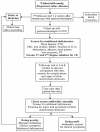Clinical Description
Celiac disease is a systemic autoimmune disease with gastrointestinal symptoms and multiple, highly variable non-gastrointestinal symptoms (see ). It is induced by dietary gluten in genetically susceptible individuals. The onset of celiac disease may occur at any age after weaning; for adults, the peak age of diagnosis is between ages 30 and 50 years. The average time between the onset of symptoms and diagnosis is 11 years. The female-to-male ratio of diagnosed celiac disease is reported to be 3:1.
Presenting signs/symptoms in celiac disease. The presenting signs/symptoms are the main indications that led to a diagnosis of celiac disease. "Bone disease" refers to evaluation for low bone density. "Incidental" refers to discovery of villous atrophy (more...)
Gastrointestinal manifestations include chronic or recurrent diarrhea, malabsorption, abdominal pain and distention, bloating, vomiting, and weight loss. As many as 50% of individuals with celiac disease do not have daily diarrhea at the time of diagnosis [Rampertab et al 2006]. Additionally, many are overweight, even obese [Murray et al 2004].
Non-gastrointestinal manifestations include dermatitis herpetiformis, chronic fatigue, joint pain/inflammation, iron deficiency anemia, migraines, depression, attention-deficit disorder, epilepsy, osteoporosis/osteopenia, infertility and/or recurrent fetal loss, vitamin deficiencies, short stature, failure to thrive, delayed puberty, dental enamel defects, abnormal liver function tests, neurologic symptoms, and various secondary autoimmune disorders [Lebwohl et al 2018].
Types of Celiac Disease
Recently a consensus paper redefined the types of celiac disease [Ludvigsson et al 2013].
Classic celiac disease refers to the presence of symptoms of malabsorption such as diarrhea, failure to thrive, and weight loss and may occur in adults and children.
Non-classic celiac disease refers to celiac disease without prominent gastrointestinal symptoms or malabsorption (see ); however, individuals with atypical celiac disease can also have gastrointestinal symptoms such as reflux, abdominal pain, bloating, vomiting, constipation, and dyspepsia. Approximately 70% of individuals are diagnosed based on extraintestinal manifestations associated with celiac disease. This group includes monosymptomatic and subclinical forms.
Iron deficiency anemia is a common presentation of non-classic celiac disease and may be the only finding.
Dermatitis herpetiformis, an intensely pruritic rash found most commonly on the extensor surfaces of the extremities, is a common non-gastrointestinal manifestation.
Other extraintestinal presentations include osteoporosis/osteopenia, dental enamel hypoplasia, infertility and/or recurrent fetal loss, vitamin deficiencies, abnormal liver function tests (typically elevated transaminases), fatigue, psychiatric syndromes, and various neurologic conditions including peripheral neuropathy, ataxia, seizures, migraines, attention-deficit hyperactivity disorder, and poor school performance.
Non-classic celiac disease usually presents in later childhood or adulthood. Children with non-classic celiac disease can present with unexplained short stature, neurologic symptoms, and delayed puberty.
Non-classic celiac disease is more common than classic celiac disease [Ludvigsson at al 2013].
Potential or latent celiac disease. Latent celiac disease is defined as a normal small-bowel biopsy in an individual with a positive celiac disease serology. A subset of such individuals subsequently develop villous atrophy if they continue to ingest gluten; others may remain in this state or celiac serology testing may become negative. Only those with severe symptoms would be advised to start a gluten-free diet [Volta et al 2016] (see ).
The celiac iceberg represents all people who are genetically susceptible to celiac disease and have a positive celiac-associated antibody test result. The majority of these individuals have latent celiac disease. The "tip of the iceberg" represents the (more...)
Removal of gluten from the diet can result in:
Reversal of (a) growth failure and (b) reduced bone mineralization in children with celiac disease;
Decreased frequency of (a) spontaneous abortions and (b) low-birth-weight infants in women with celiac disease;
Reduced risk for certain types of cancers including small-intestine adenocarcinoma, esophageal cancer, and non-Hodgkin's lymphoma;
Reduced risk of mortality in symptomatic individuals.
Refractory sprue/celiac disease (RCD). Refractory sprue or RCD refers to persistence of symptoms of frank malabsorption with persistent intestinal inflammation and villous atrophy despite a strict gluten-free diet for at least six to 12 months. All individuals with refractory sprue are older than age 20 years.
Primary refractory sprue describes the condition in which individuals have never responded to a gluten-free diet.
Secondary refractory sprue refers to the condition in which individuals have a full recovery, followed later by a relapse, despite adherence to the gluten-free diet.
An alternate classification for RCD involves the characterization of the intraepithelial lymphocytes (IELs) in persons with RCD:
In active, uncomplicated celiac disease the IELs have surface expression of CD3 and CD8, a normal occurrence. In addition, these lymphocytes are not clonally restricted (i.e., polyclonal).
In RCD1, the IELs are normal.
In RCD2, the IELs are abnormal in the following ways:
They have lost surface expression of CD3, CD8, and the T-cell receptor.
CD3 is detectable within the cell.
They have generally become clonal.
RCD1 is considered to be relatively common. Individuals usually respond to corticosteroids (e.g., budesonide, prednisone).
RCD2 is rare. An international series demonstrated a 30% five-year mortality rate and prognostic factors that determined survival [Rubio-Tapia et al 2016]. Poor survival is typically due to a high rate of progression to enteropathy-associated T-cell lymphoma [Chander et al 2018].
Prevalence
Celiac disease affects approximately 1% of individuals in the US. Celiac disease is considered to be common in Europe, the US, Australia, Mexico, and some South American countries. The highest reported prevalence of celiac disease is 5.6%, found in a refugee population in North Africa.
The prevalence of celiac disease is increased in individuals with the following disorders [NIH Consensus Committee 2005]:
Down syndrome (prevalence of celiac disease: 5%-12%)
Turner syndrome (~3%)
Selective IgA deficiency (~2%-10%)
Insulin-dependent diabetes mellitus (~6%)
Sjögren syndrome (~5%)
Autoimmune thyroid disease (~2%-4%)







